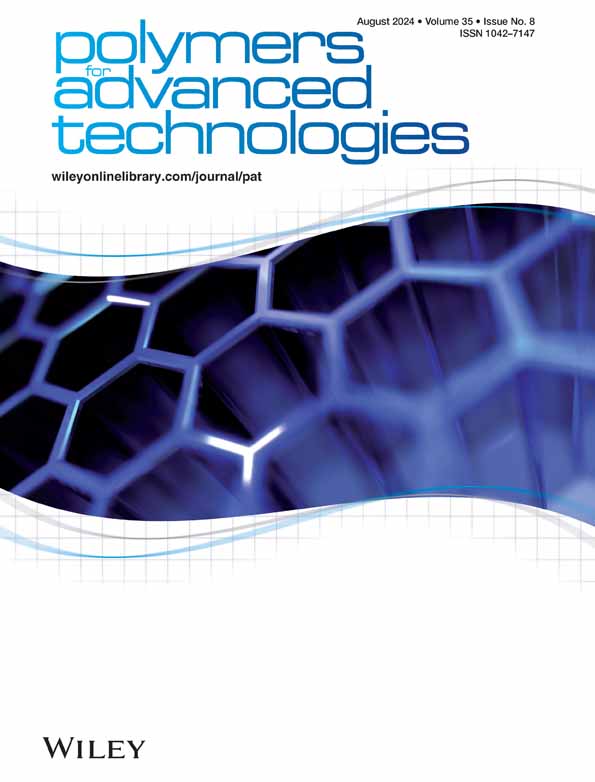生物聚酯杂化纳米复合材料的物理、形态和机械性能比较
IF 3.4
4区 工程技术
Q2 POLYMER SCIENCE
引用次数: 0
摘要
当务之急是改善聚乳酸(PLA)、聚己二酸丁二醇酯(PBAT)和聚己内酯(PCL)等可生物降解聚合物的物理、形态和机械性能,以便更大规模地使用它们。使用纳米夹杂物开发混合纳米复合材料可以提高所需的质量。在这里,我们引入了一种交互式纳米增强方法,通过将氧化石墨烯(GO)和羧基功能化的 MWCNT(f-MWCNT)结合在一起,使其化学键协同增强,从而改善性能。通过熔融混合工艺,在生物聚酯中添加 2 重量百分比的恒定填料,并检测不同的物理性质,如吸水性、固有粘度和硬度。为了全面评估纳米填料的功能化情况,使用了广角 X 射线衍射(WAXD)、拉曼光谱和傅立叶变换红外辐射(FTIR)分析。电子显微镜显示,配对的纳米颗粒和聚合物基质似乎混合得很好,电子显微镜还显示出良好的分散性,并在整个基质层中形成了增强网络微结构。对结果的全面分析表明,有效的应力传递、延迟故障开始和微裂纹的产生以及耗散额外的机械能都有助于高效混合网络的形成,从而改善了除某些纳米复合材料以外的混合填料纳米复合材料的机械性能。这些发现为化学改变可生物降解聚合物(如聚乳酸、PBAT 和 PCL)提供了一种可行的技术,可用于生物医学、废水管理和农业应用。本文章由计算机程序翻译,如有差异,请以英文原文为准。
A comparison of physical, morphological, and mechanical properties of bio‐polyester hybrid nanocomposites
It is imperative to improve the physical, morphological, and mechanical properties of biodegradable polymers like polylactic acid (PLA), poly (butylene adipate‐co‐terephthalate) (PBAT), and polycaprolactone (PCL) in order to employ them on a larger scale. The development of hybrid nanocomposite materials using nano inclusions can improve desired qualities. Here we introduced an interactive nano reinforcement approach to improve the properties by combining graphene oxide (GO) and carboxyl functionalized MWCNT (f‐MWCNT), to provide for their chemical bonding for synergic reinforcement. A constant filler 2 wt.% was added to the biopolyesters by melt blending process and examined the different physical properties like water absorption, intrinsic viscosity, and hardness. To completely evaluate the functionalization of the nanofillers, wide‐angle X‐ray diffraction (WAXD), Raman spectroscopy and Fourier transform infrared radiation (FTIR) analyses were used. The paired nanoparticles and polymer matrix appear to mix well together, as shown by electron microscopy, which also reveals good dispersion and the creation of a reinforcing network microstructure across the matrix layer. A thorough analysis of the results showed that effective stress transmission, delaying the start of faults and generating microcracks, and dissipating additional mechanical energy all contributed to efficient hybrid network formation, which improved the mechanical properties of hybrid filler nanocomposites except some nanocomposites. These findings offer a viable technique for chemically altering biodegradable polymers, like PLA, PBAT, and PCL for use in biomedical, wastewater management, and agricultural applications.
求助全文
通过发布文献求助,成功后即可免费获取论文全文。
去求助
来源期刊

Polymers for Advanced Technologies
工程技术-高分子科学
CiteScore
6.20
自引率
5.90%
发文量
337
审稿时长
2.1 months
期刊介绍:
Polymers for Advanced Technologies is published in response to recent significant changes in the patterns of materials research and development. Worldwide attention has been focused on the critical importance of materials in the creation of new devices and systems. It is now recognized that materials are often the limiting factor in bringing a new technical concept to fruition and that polymers are often the materials of choice in these demanding applications. A significant portion of the polymer research ongoing in the world is directly or indirectly related to the solution of complex, interdisciplinary problems whose successful resolution is necessary for achievement of broad system objectives.
Polymers for Advanced Technologies is focused to the interest of scientists and engineers from academia and industry who are participating in these new areas of polymer research and development. It is the intent of this journal to impact the polymer related advanced technologies to meet the challenge of the twenty-first century.
Polymers for Advanced Technologies aims at encouraging innovation, invention, imagination and creativity by providing a broad interdisciplinary platform for the presentation of new research and development concepts, theories and results which reflect the changing image and pace of modern polymer science and technology.
Polymers for Advanced Technologies aims at becoming the central organ of the new multi-disciplinary polymer oriented materials science of the highest scientific standards. It will publish original research papers on finished studies; communications limited to five typewritten pages plus three illustrations, containing experimental details; review articles of up to 40 pages; letters to the editor and book reviews. Review articles will normally be published by invitation. The Editor-in-Chief welcomes suggestions for reviews.
 求助内容:
求助内容: 应助结果提醒方式:
应助结果提醒方式:


